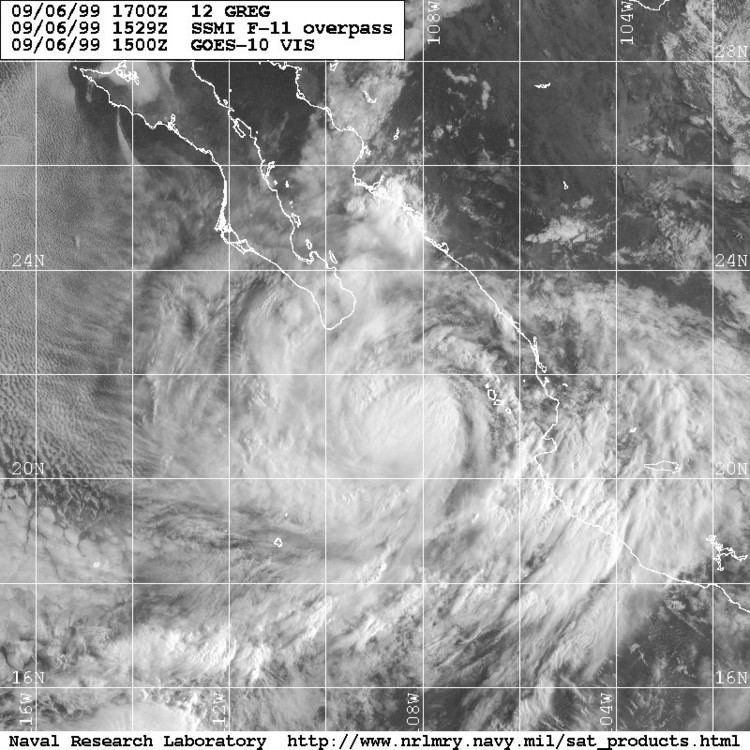Formed September 5, 1999 Fatalities 10 total Affected areas Western Mexico, Mexico | Dissipated September 9, 1999 Highest winds 121 km/h | |
 | ||
Lowest pressure 986 mbar (hPa); 29.12 inHg Areas affected Western Mexico, Baja California Peninsula Date 5 September 1999 – 9 September 1999 Similar Hurricane Eugene, Hurricane Calvin, Hurricane Dora, Hurricane Hilary (2011), Hurricane Adrian | ||
Hurricane Greg was a tropical cyclone which affected western Mexico during the 1999 Pacific hurricane season. Although weak, only a Category 1 on the Saffir-Simpson Hurricane Scale, Greg brought heavy rain. Those rains caused flooding, which killed ten people. The rains were also high enough in one locale to make Greg one of Mexico's rainiest Pacific hurricanes.
Contents
Hurricane Greg was the twelfth tropical cyclone and fifth hurricane of its season. Greg was also the first of two Pacific hurricanes to form in September, 1999. It was the only system of the season to make landfall.
Meteorological history
Hurricane Greg's origins lie in a tropical wave that had split while over the Atlantic. The northern part formed Tropical Storm Emily in the Atlantic. The southern part kept going, crossed Central America over three days starting on August 31, and started developing. A mid-level circulation developed while the wave was partially inland over Mexico and while it was meeting a monsoon-type cyclone. At that time, thunderstorms and convection developed, and a Tropical Depression Twelve-E formed on September 5.
Twelve-E intensified steadily, and became a tropical storm the same day it formed and was named Greg. convection increased, and a ragged-looking eye formed. Greg was upgraded to hurricane status on September 6 as it approached the southern part of the Baja California Peninsula. Its winds stayed at 75 mph (120 km/h) and it reached its lowest central pressure of 986 mb (29.1 inHg). When it was close to Cabo San Lucas, wind shear weakened Greg to a tropical storm. When it had winds of 57 mph (93 km/h), it made landfall near Cabo San Lucas on September 7. It passed over the extreme southern part of the Baja California Peninsula and turned to the north-northwest. Greg entered cooler waters and weakened to a tropical depression on September 8. Greg dissipated the next day.
Preparations and impact
Starting on September 5, tropical cyclone watches and warnings were issued for various parts of Mexico. The first was a tropical storm warning issued September 5 for the coast of Mexico from Manzanillo, Colima, to Cabo Corrientes, Jalisco. It was extended to Lázaro Cárdenas, Michoacán, later that day. On September 6, a Tropical Storm Warning was issued for the east coast of Baja California south of La Paz. At the same time, a watch was issued for the west coast of Baja California south of Punta Abreojos; it was later upgraded to a warning south of Cabo San Lázaro. Later on September 6, the Tropical Storm Warnings on the east coast of the peninsula and the west coast south of Arroyo Seco was upgraded to a Hurricane Warning. A Tropical Storm Watch was then issued for the Gulf of California Coast of the peninsula from La Paz to Loreto. The Hurricane Warnings were downgraded to Tropical Storm Warnings on September 7. The warnings on the east coast of the Baja California Peninsula were dropped on September 8. The remaining warnings and watches were dropped later that day. The Mexican Army and Navy prepared for rescue operations. Officials ordered more than 1000 people to evacuate from low-lying areas.
Both Hurricane Greg proper and its predecessor disturbance brought heavy rain to much of Mexico. The highest report was of 22.23 inches (566.9 mm) in Tecomán, Colima. That makes Greg Mexico's Pacific hurricane with the sixth-highest point maximum and the Pacific hurricane with the ninth-highest point maximum overall.
Greg's heavy rain caused flooding in the states of Colima, Michoacán, Sinaloa, Nayarit, and Jalisco. It was most severe along the Los Mezcales River. The flooding killed ten people. In addition, 2000 people were rendered homeless and 2000 others were affected in some way. Greg also churned up heavy surf, which crashed ashore along Mexico's Pacific coast.
Remnants of the tropical storm, in combination with a low pressure system, produced unusual and spectacular thunderstorms in the Central Coast and the San Francisco Bay Area regions of California. The storm caused widespread power outages and also caused isolated damage to houses and vehicles, as well as causing several small wildfires. Overall damage was relatively limited, however.
